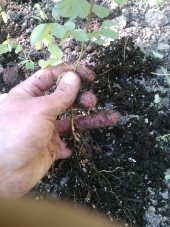
 1
1








Myrth
https://ello.co/myrthcowgirl




 4
4





 2
2




 1
1




 7
7




When you reach your lowest point, you are open to the greatest change.
-Avatar Aang
 2
2




 1
1




 10
10




Cultivate abundance for people, plants and wildlife - Growing with Nature




 5
5




Some places need to be wild

 3
3




List of Bryant RedHawk's Epic Soil Series Threads We love visitors, that's why we live in a secluded cabin deep in the woods. "Buzzard's Roost (Asnikiye Heca) Farm." Promoting permaculture to save our planet.




 2
2








 1
1




 1
1




Sometimes the answer is nothing





Joseph Lofthouse wrote:For me, black locust is a barely viable species. It sorta grows here, but it doesn't thrive, and it's not invasive.
Come join me at www.peacockorchard.com
 2
2




wayne fajkus wrote:I look at the OPs pictures. They tell a lot. Everything is green. The trees look healthy. I see that and question why black lotus is needed.




bob day wrote:I'm going to go out on a limb and post this from memory- always a dangerous thing,
Black locust I think is a seed that does not germinate without special treatment. --feed to a horse and plant the manure, or boil water and pour over the seeds-let sit till cool- remove the seeds that have swollen and do it again with the remainder. until you are tired or all the seeds are swollen- note , do not boil the seeds, that slightly hotter temperature will kill them
I plan to plant thornless honey locust, it is a forage crop for cattle-- black locust is a forage more for turkeys.
both black and honey locust are highly durable wood, and will outlast treated lumber in the ground, maybe outlast you.
Honey locust (probably black locust also) are of a class known as farmer's trees. At about 20-30/acre they will form a root network under the soil, as well as a taproot that mines deep minerals. This root network catches nutrients before they goes below root depth and brings them back as leaves, so any fertility you add to the soil stays there. Estimates of as much as 100% increase in crop or pasture, the low estimate is 50%. you can plant grass or crops right up to the base of the tree and they are not adversely affected.
Myrth
https://ello.co/myrthcowgirl





 4
4




Eric Hanson wrote:For my purposes, BL is a terrible nuisance, mainly because of its wicked thorns. I have a small tractor and I have had to do several tire repairs due to BL thorns poking through my tires. To be clear, this was a diesel tractor with R4 industrial tires and not a riding mower, so in my case, I have no use for BL and wish it did not grow on my property.
![Filename: honey-locust-thorn.jpeg
Description: [Thumbnail for honey-locust-thorn.jpeg]](/t/102408/a/72032/honey-locust-thorn.jpeg)
Works at a residential alternative high school in the Himalayas SECMOL.org . "Back home" is Cape Cod, E Coast USA.














Some places need to be wild


















Some places need to be wild




Eric Hanson wrote:
It’s not impossible that what is being called black locust around here is in fact a different species, but whatever we have has a dark bark and 3 inch long wicked sharp and incredibly strong thorns.
-- Wisdsom pursues me but I run faster.

 1
1




 ).
).
| I agree. Here's the link: http://stoves2.com |






